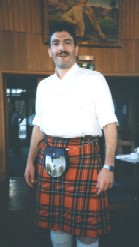![]() Kilt
Kilt
 Kilts do not appear to have become a symbol of Irish nationality as did they became in Scotland. The kilts worn by Irish pipers and dancers appear to have little relationship to the actual kilts worn by the Gaelic people of Ireland. The current Irish kilt appears to be a copy of the short kilt fashioned by an Englishman in the 18th century and embraced by a generation of romantic poets and authors and even Queen Victoria herself. Unlike Scotland, there appears to have been no real revival of kilt wearing in Ireland beyond ceremonial occasions or ethnic events. The British Army did adopt a kilt uniform for some Irish units, as it occurred in World War I. Irish boys do not appear to have kilts in the 19th Century and early 20th Century, but, especially those living in rural areas, wore flannel dresses. These dresses were not kilts associated with Celtic warriors, but rather were dresses designed to confuse the fairies which according to folklore would steal male children. It was a common practice in the early 19th century and while it declined in the 19th Century, was still the fashion in some areas until after World War I (1914-18).
Kilts do not appear to have become a symbol of Irish nationality as did they became in Scotland. The kilts worn by Irish pipers and dancers appear to have little relationship to the actual kilts worn by the Gaelic people of Ireland. The current Irish kilt appears to be a copy of the short kilt fashioned by an Englishman in the 18th century and embraced by a generation of romantic poets and authors and even Queen Victoria herself. Unlike Scotland, there appears to have been no real revival of kilt wearing in Ireland beyond ceremonial occasions or ethnic events. The British Army did adopt a kilt uniform for some Irish units, as it occurred in World War I. Irish boys do not appear to have kilts in the 19th Century and early 20th Century, but, especially those living in rural areas, wore flannel dresses. These dresses were not kilts associated with Celtic warriors, but rather were dresses designed to confuse the fairies which according to folklore would steal male children. It was a common practice in the early 19th century and while it declined in the 19th Century, was still the fashion in some areas until after World War I (1914-18).
![]()